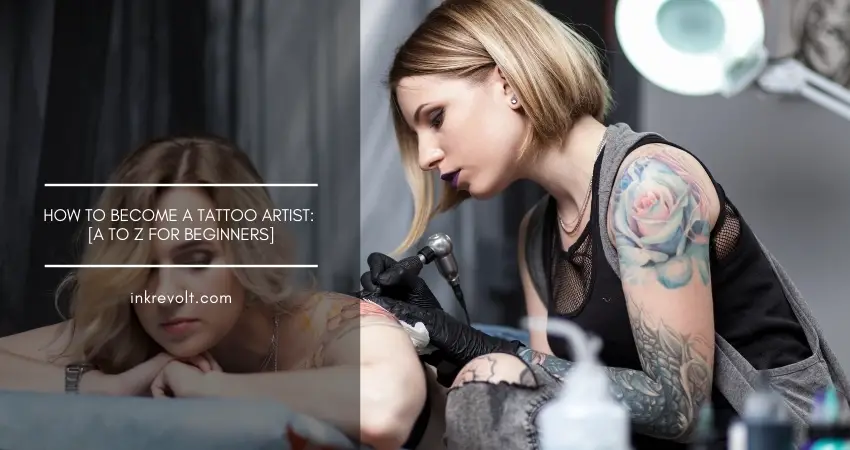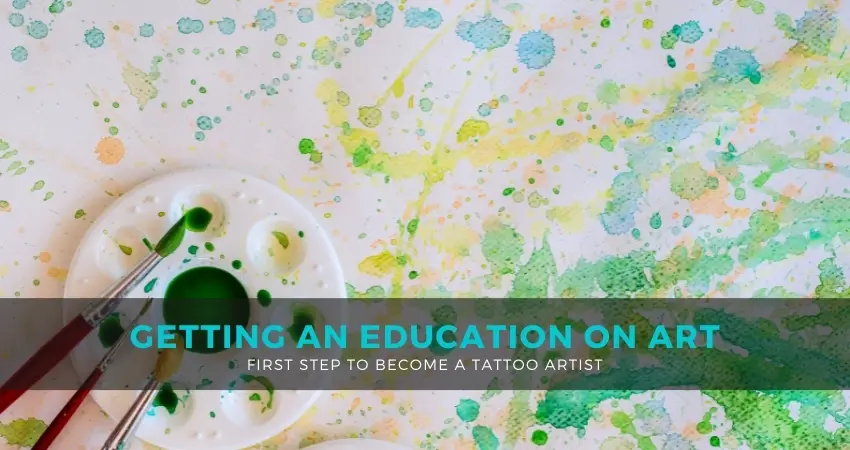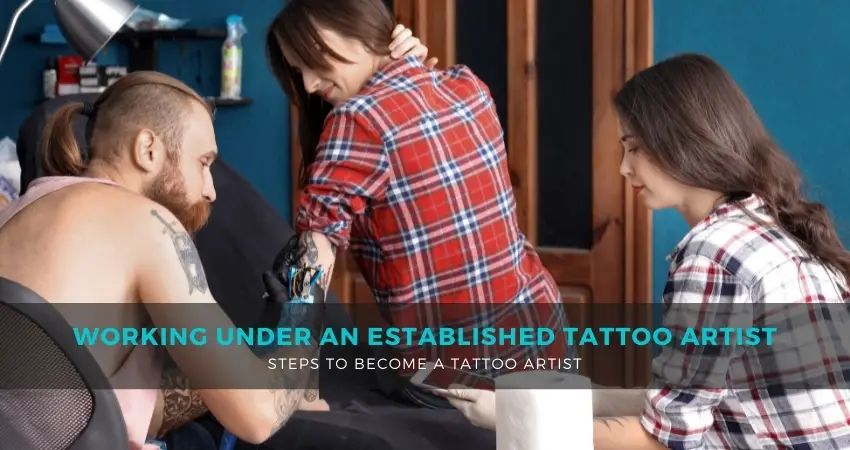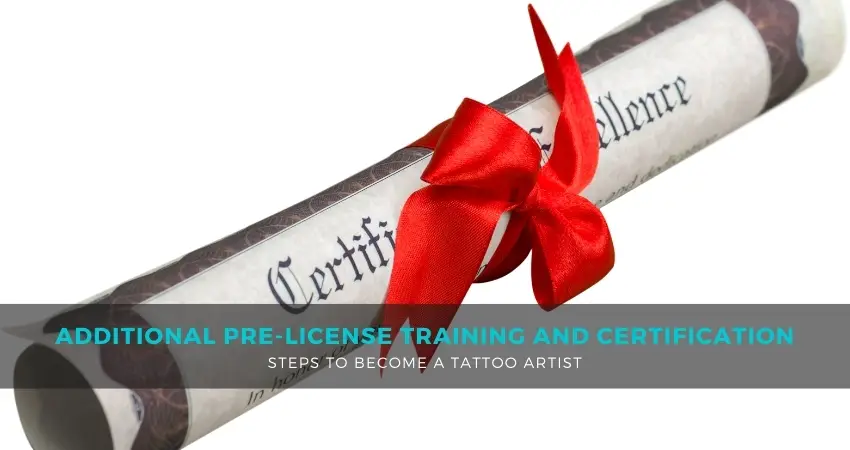How To Become A Tattoo Artist? [A to Z For Beginners]
If you are interested in design, art and passionate about tattoos, you can think of persuading the career of a tattoo artist. Like other creative professions, it is not easy. However, it is also very much possible if you can do what it takes.
To become a professional tattoo artist, there are several paths to follow depending on your talent, financial ability, available opportunities, and the type of tattoo artist you want to be. But all of them have common steps that every aspiring artist has to follow to develop their skills, gather sufficient knowledge, and grasp the art of tattooing.
Here is how you can get started.
How To Become A Tattoo Artist: Steps To Follow

1. Learning To Draw
The first and foremost requirement of making a tattoo is a visually fascinating drawing. You must concentrate on improving our drawing skill and illustration technique before even wondering about designing or practicing tattooing. So how can you do that?
Start Practicing By Yourself
The first option is to start practicing by yourself. Get yourself a pencil suitable for drawing and a sketchbook to draw from during your leisure. You need nothing else to initiate this step.
Draw things you think, see, and hear. Draw anything that gets your attention. Concentrate on what others describe and put that into a piece of art. It will be worth it when you get requests from people later in your career.
Studying The Art Pieces Of Prominent Tattoo Artists
Cherish your passion by studying the masterpieces of notable tattooists. Look for well-reputed artists, learn their tattoo types and styles, and contemplate their creativity of converting thoughts into art with a machine and ink.
See what vibes with you and find your style. While doing that, research what the market thinks about that.
Here are some popular names for you to look upon the internet: Miya Bailey, Mirko Sata, Rit Kit, Chris Nunez, and Frank Carriho.
Digging Into Different Forms Of Art
Suppose you do not know what type of art suits you the most. To find it out, you can start trying out as many forms of art as you can before jumping to a decision. Create abstract art, contemporary art, fine art.
If a logo or t-shirt design catches your eyes, grab your sketchbook. Keep doing it until you find your type. When you do, ask yourself if you really like it and then proceed with your goal to become a tattooist.

2. Getting An Education On Art
Now, this is important. If you seriously consider tattooing as a profession, it is necessary to look for opportunities to become a knowledgeable artist. But that also demands you to be aware of your financial abilities and assess your skill level as a tattoo artist.
That will help you decide whether you need to pursue some conventional art degree, get training at some tattoo institute, attend classes in some community college, or take the self-taught option.
The point is that you will become a better tattoo artist if you spend more time developing your tattoo skills. It is not that you must get formal education or have a diploma to be a tattooist. So the decision is huge and pressurizing. Calculate the pros and cons to choose an option. Take your time because it will be one of the most impactful decisions in your career.
Attending A Community College To Take Classes On Art
It is the most budget-friendly way to get educated about art, although it is not as comprehensive as getting a formal degree from a tattoo university. Generally, a community college will teach you the basic concepts of tattooing. You will also learn to create different types of art, which will polish your skills.
Earning A Degree In Art
If you want to earn a formal and traditional degree in art and can afford it, pick a university with a reputation for its arts program. You may not find programs particularly arranged for tattooists.
So, search for a university offering a program in illustration, design, graphic design, performing art, commercial art, or digital art. You will be able to build up an attractive background in arts with a program like this.
3. Establishing The Basic Concepts And Skills Of Design
Although some people do not consider it a traditional form of art, tattooing consists of essential design tools. That is why it is mandatory for you to know how the elements of different designs work. And that is regardless of how you get the knowledge.

Learning The Graphic Design Fundamentals
You may get an art education or self-teach yourself drawing skills. Either way, it will be critical to learn the graphic design fundamentals. First, it will require you to understand the concepts of size, color, texture, value, shape, and line.
After that, you will learn the applications of the theories to make any image you like while mastering how to make stencils and eventually draw your tattoo designs on people’s skin.
Pro Tip: Get pig skins to practice your tattooing skill before applying it on people.
Learning The Graphic Design Principles
Learning the basics is not all when your goal is to be a professional tattoo artist. You will also have to master graphic design principles like balance, space, contrast, repetition, proximity, and alignment. They help a tattooist establish the art’s foundation without which a drawing is never complete.
The manifestation of each foundation varies from one piece to another, which throws you the challenge to build the ability to apply the principles in different ways.
4. Building A Portfolio
A portfolio is a vital thing for a tattooist. It lets mentors have a glance at your most impressive pieces and decide if your art style matches their requirements for an apprentice. How you build your portfolio makes an impression on the potential mentors. What can you do to create an impressive portfolio?
Creating A Portfolio Like A Professional
Your portfolio needs to have a look that is both professional and attractive. So do not put low effort into making it. Instead, buy a three-ring binder that comes with sheet protectors.
Or you could also have its pages matted. It should look uniform, sleek, and inviting from the outside so that a mentor feels intrigued to look into your work. Otherwise, a shabby presentation may discourage them from seeing what is inside and make them reject you.

Including The Best Designs In The Portfolio
The number of drawings and designs you can include in the portfolio starts from 25. You can select 100 at the maximum. They can be either your original works or copies. While picking the designs, look for those that showcase your talent, versatility, and skill as an aspiring tattoo artist.
You can also include several work examples that you did in gray and black. It is also alright if your masterpiece is a composition of colorful illustrations. It may not look great as a tattoo, but as long as it exhibits your strength and caliber for making tattoo designs, it is more than good to go.
Common Mistakes To Avoid While Creating A Portfolio
There are some things you should not even think of doing while setting up your portfolio. For example:
- Copying Other Tattoo Artists’ Work
Copying others’ work is plain plagiarism, and that could cause you to face legal action. Even if you do not, the tattoo studio will know about this and will reject your application. But if it is the worst-case scenario, it will ruin your reputation even before your career gets the chance to start.
- Submitting Pictures Of Your Tattoos
If you are not a professional tattooist, do not ever include your tattoos’ pictures, regardless of how great you think they are. First, it is not legal to make tattoos if you do not have a license. Besides, it shows your reluctance to take tattoo art and your client’s health seriously.
It also gives your potential mentors the idea that you might have scratcher habits needed to be sorted out, which means they will have to try hard to guide you.
Making The Portfolio Engaging
Here are some suggestions you can follow to make your portfolio look engaging:
- Attaching A Cover Letter With The Inclusion Of Your Resume: Your resume will show your educational background and experience related to tattooing, whereas your cover letter will address the potential mentors by their names. Both of these will add a touch of professionalism to your portfolio.
- Including The Completed Work Only: If you have a few completed designs and drawings, wait until you complete more pieces to include in your portfolio. Use the finished ones only and include copies of what each design looked like during different stages of the designing or drawing phase.
- Memorizing Some Points To Talk About Each Work: The mentor will be highly likely to ask you some questions regarding your work. Make short speeches about each of them with vital information and memorize them so that you do not get confounded when asked to discuss your art.
- Leaving A Business Card: Make your personal business card. If you do not get an appointment, the tattoo artist may not assess your portfolio instantly. In that case, you can leave your business card containing your name, address, and other information. It should also have a link that will direct the mentor to your online portfolio, where they can view it whenever they want.
5. Working Under An Established Tattoo Artist
Once you get the confidence that you have the caliber to draw and design attractive tattoos, you should think of gaining practical experience and starting implementing the techniques and styles you learned in real-life environments.
You cannot learn to tattoo by reading books only. You have to work under mentors who have been involved with the profession for a long time and are willing to guide you. You can remember the criteria below while on the look-out for a mentor.
- The tattoo artist should work at a well-reputed tattoo shop where they get lots of clients and maintain standard hygiene guidelines. Steer clear of the often empty shops that cannot give you much about abiding by hygiene practices. Or simply, if you do not get a good vibe, if the environment does not seem delightful, cross it off your list.
- The artist has had at least one apprentice before. Mentoring is quite challenging, even for the artists that are the most seasoned ones. So, look for a tattoo artist with mentoring experience to better understand how things work in the mentoring phase.
- The tattoo artist you select as your mentor should throw you challenges, make you accountable, and unleash your potential at its highest level. An artist like that truly helps you find your inner talent and put it to use. Do not choose someone who you can please without putting in much effort. That will not help you in the future.

Approaching A Tattoo Shop To Get An Apprenticeship
Your impression matters a lot here. So, before going to a tattoo shop where you would like to get mentored, do your research. Learn a lot about the shop. Gather knowledge about their business, artists, and other important details.
Many people make a mistake in this step by calling the tattoo studio and managing an apprenticeship over the phone. But think about it. A popular tattoo studio has to communicate with lots of individuals.
They are also likely to get apprenticeship requests from others like you. So you cannot blame them if they forget to call you back. The best option here is to go to the shop and contact the people physically. That way, they are more likely to remember you. Drop by any day in the week during an afternoon when the shop is at its least busy time.
When you enter the tattoo shop, you will see the receptionist or an artist in place of the receptionist who might be having their lunch. Whoever you meet, be humble and treat them with respect. Whether you will get your apprenticeship or not depends largely on how they see you.
How Much Does An Apprenticeship Cost?
Tattoo apprenticeships hardly pay, if ever. It is mainly the other way around. You may find a few at no charge, but most will come at a cost.
Most apprenticeships you will get at reputed tattoo shops will cost you around $5,000. However, it may go beyond $10,000 in some cases, varying from the mentor’s popularity and skill.
That is why tattoo apprentices should have a part-time job to keep their financial stability while taking their training.
Understanding The Contracts Of Tattoo Apprenticeships
When you and the mentor agree on the apprenticeship, the tattoo studio will give you a contract to sign. It is a legal paper bearing the expectations and responsibilities of the two parties. It will protect either party’s interest if one fails to meet any contractual obligations.
The contract also tells you the duration of the apprenticeship, its payment amount and process, your weekly and daily responsibilities, expectations you should have from the mentor, etc. Apart from that, it will say if the tattoo studio requires you to work there for some time after the completion of the apprenticeship program.
To make sure you understand everything wholly and completely, you should consider hiring an attorney to review the contract before signing it. That way, you can also secure the protection of your interests.
6. Completing The Apprenticeship And Learning The Trade
You have to be an apprentice at a tattoo shop and complete your apprenticeship before you begin tattooing as a professional artist. A formal training shows you the ins and outs of the trade. You can do that either with a mentor or by looking for a tattoo studio that wants an apprentice.
Below goes a list of the things you should bear in mind while starting your apprenticeship.

A Huge Upfront Investment
There is more to the cost of an apprenticeship than you think. It will require you to have the basic supplies like tattoo guns, art supplies, sterile equipment, and others. Be ready to spend a fortune to learn how to become a tattoo artist.
Learning To Do The Job
Tattoos are pieces of art, yes. But you cannot convert every artsy stuff into a tattoo. You have to learn to make tattoos in a way that makes them look great on the skin and last a really long time without needing a touch-up.
The place, size, and details of a tattoo shape its appearance over time. Small tattoos poorly placed with lots of details will have uneven healing, making the lines blurred, and the ink spread over the skin. It is things like that an apprenticeship teaches you before you step on the career professionally.
Learning To Use A Tattoo Device And Work With Tattoo Ink
It is difficult to deal with flesh and ink as artistic mediums. Plus, you will never find two exactly the same bodies. As you progress in your apprenticeship, you will see how tattooing is different from other art mediums and learn to make excellent art on one’s skin by using a tattoo device and ink.
Learning Hygienic Health Practices
Every tattoo is a form of body modification because it punctures your skin and makes it bleed. So there are some hygiene standards that you must meet for your and your client’s safety.
During your apprenticeship, you will learn to sterilize a work field, keep your devices clean, change your gloves, and do other essential practices.
Remember here that reputable tattoo artists consider hygiene and safety seriously. So, review their hygiene practices before you agree to learn how to become a tattoo artist from them.
It would be even better if you could have a tattoo done by the tattooist you want to be your mentor if possible. That will give you an overall idea of the things you should ensure beforehand.
Learning Customer Service And Business Skills
Most tattoo artists have to learn several professional skills. These skills require them to learn how to interact with their clients, process payments, and balance ledgers.
When you are searching for apprenticeship offers, see which ones offer you more than tattoo training. The ones that will also teach you the basic skills to run a tattoo studio should be your preference. That is very important for people having a dream of running their own tattoo shops one day.
Working Voluntarily For One Year At Least
Since most apprenticeship programs are unpaid, you will make lots of tattoos for free. That means no earnings will come out of the training.
So, set aside sufficient funding or have an income source available to bear your living expenses. You can make a plan for that.
Consider at least a year; it’s better if you plan for longer because sometimes the program may take longer than twelve months.
7. Obtaining Additional Pre-License Training And Certification
In the next step, after completing your apprenticeship, you should get enrolled in additional training courses and obtain some certifications to fulfill the tattoo licensing criteria of your state. You may have to attend classes in health and hygiene, disease control, and other relevant health concepts, which depend on your state. For more examples:
A Bloodborne Pathogen Certification
Since human skin is a tattooist’s canvas, it is mandatory that they maintain the health guidelines strictly. So, the main goal of the training will be to learn how to prevent bloodborne pathogens from spreading and preserve your and your client’s health.
At one stage during the apprenticeship or afterward, you will have to gain certifications in preventing infections like Hepatitis C and HIV from spreading while making a tattoo. Along with them, you will have to be ready to present bloodborne pathogen certification proofs when required.

Training On Communicable Diseases, Skin Diseases, And Their Prevention
Before you become certified, programs for Bloodborne pathogen certifications usually ask you to take classes or attend seminars on subjects like disease management. Others only take a test where you have to show your knowledge.
As an aspiring tattoo artist, it is a must for you to be well-educated about disease types, their spread through the process of tattooing, and their prevention.
8. Getting The License
If you have successfully passed in all the seven steps above, take a bow because you have made it! Congratulations! Now you have to follow the last few steps to become a tattoo artist.

Checking The State Requirements
The requirements of getting a license vary from one state to another. Some states require tattooists to complete a training program of 360 hours at the minimum with other tests and assessments to get licensed. In contrast, according to other states, only the tattoo shop should have a license.
So, while checking your state’s requirements, go through the other states’ once as well. You can get a tattoo license in two or more states if you can fulfill their criteria.
Applying For The Tattoo License
After meeting the prerequisites, you have to make an application to get your license. The process is not complex at all. You will get a form to fill out and pay the fee. Although it varies from one state to another, that is mostly it.
9. Purchasing The Tattoo Equipment
Each tattooist has equipment preferences. Some like specific styles and models of tattoo machines, whereas others get nitrile gloves and avoid latex because of allergy issues.
Generally, a tattoo shop requires a tattoo artist to get supplies on their own. So, you will have to invest in the essentials in the beginning. Your collection will grow more when you become more experienced.
The Equipment You Need To Buy To Start Your Career
You will have to purchase at least a couple of tattoo machines as per your preferences. Besides, you should save up to buy ultrasonic grips and tubes, cleaning soap, sterilized needles for shading and lining, gloves, ink cups, spray bottles, and other stuff to clean the workplace.
The total cost of the supplies will be several thousand dollars. Depending on the brands, it may cost you more.
10. Becoming A Tattoo Artist
Learning how to become a tattoo artist finally ends at this step. Now you are ready to work as a professional tattooist. You have two options to start your new path: working at a running tattoo studio or being on your own.
Applying At A Tattoo Studio
Now that you have a license, you can apply to work as a tattooist in any tattoo studio. If you do not have any contract with the shop where you did your apprenticeship, try at the local shops with a vacancy.
If they are not currently looking to recruit people, you can give them their portfolio and resume for consideration. That is because tattoo shops often recruit new tattoo artists if they like their work, even when they are not advertising for employment formally.
Opening A Studio Of Your Own
If your dream is to have a tattoo studio of your own instead of working at someone else’s shop, you should do that early rather than later. Think and plan about what you will need to open a shop, how you can manage the furniture, extra equipment, and rental space.
Meanwhile, you should also assess your competitors and target market. If necessary, you should pick another location where you are more likely to flourish your business.
Final Words
The procedure is lengthy, time-consuming, and requires true efforts. But if you think about it, the first and only thing you need to learn for becoming a tattoo artist is a pencil and paper to practice drawing.
Then, if you are persistent enough, the rest of the procedure will proceed step by step. A piece of advice here would be to plan everything, especially the financial preparation. You do not want to stop and go back when you are halfway through the journey. A solid and foolproof plan will help you pass all the steps successfully with no setbacks.
Nevertheless, it will take years to become a professional. But if you keep working on it, nothing can stop your dream from coming true.
Best of luck!
